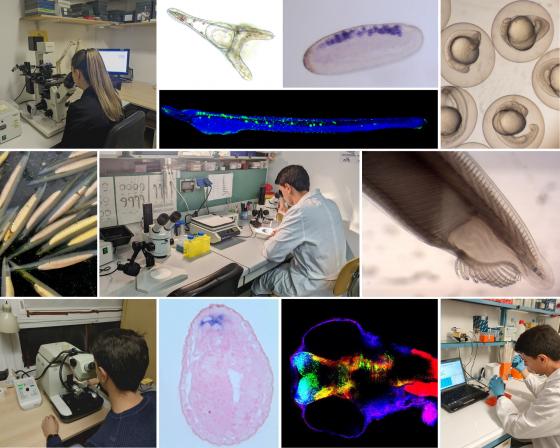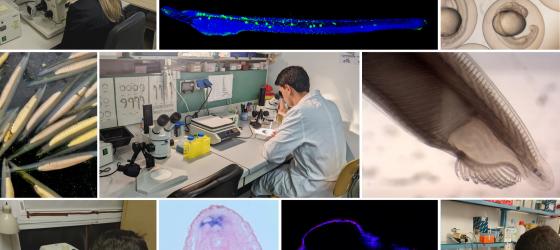LOCATION: Palazzina delle Sceinze (Building 8), 1st and 2nd Floor, Rooms I.05-06-10-20-21; II.06-07-08-09-15
RESEARCH TOPICS:
- Evolution and development of the cordate nervous system. By studying the development of cephalochordates (amphioxus), the earliest branching chordates, we aim to reconstruct the evolutionary events that drove the evolution of the chordates, particularly of vertebrates. Our approach is based on the integration of functional, gene expression, and morphological data from a comparative perspective, comparing our observation with what is known in other organisms, vertebrates and invertebrates. At present, the focus is on neurogenesis and the evolution of glial cells.
- Zebrafish as a model for human diseases. In the last years, the teleost zebrafish (Danio rerio) emerged as a great non-mammalian animal model to study human diseases. We are mainly focused on Alexander disease, a rare leukodystrophy caused by missense mutations of the gfap gene. We generated a transgenic zebrafish line producing a mutated form of the human GFAP protein and are working on its characterization by morphological, transcriptomic, proteomic, and biochemical analyses.
- Innate immunity and cancer. Natural killer (NK) cells are important innate lymphoid cells for contrasting tumor development. NK cell function is finely regulated by a balance of inhibitory and activatory receptors. Inhibitory receptors inspect the correct exhibition of class I HLA molecules by autologous cells. These molecules are often absent in cancer cells, which cannot engage inhibitory receptors on NK cells and are, therefore, susceptible to NK-mediated killing. Cancer cells, however, often express ligands (e.g., PD-L1) of other inhibitory receptors (e.g., PD-1) that prevent the cytotoxic function of NK cells. This inhibition can be overcome using specific monoclonal antibodies. By performing phenotypic (immunohistochemistry), functional, and molecular (qRT-PCR, transcriptomics, proteomics, miRNomics) analyses of NK cells from cancer-affected patients and cancer cells, we try to identify new molecular targets for the clinical treatment of specific tumors.
RESEARCH GROUP MEMBERS: Simona Candiani, Matteo Bozzo, Deianira Bellitto.
LINK TO RESEARCH LINES, PROJECTS AND PUBLICATIONS: JPI Oceans, bando 2021 “Underwater noise in the marine environment”: Deuteronoise(subcontractor), AIRC 2021,
ORCID: 0000-0002-4453-5475/0000-0002-7452-3758
LABORATORY EQUIPMENT: Olympus IX71 epifluorescence inverted microscope equipped with colour camera and Narishige micromanipulators, Leica DMRB compound microscope, Leitz Laborlux S compound microscope equipped with colour camera, Olympus BX60 epifluorescence compound microscope equipped with colour camera and Microvisioneer manual scanning system, Leica RM2145 rotary microtome, paraffin oven, resin curing oven, n.5 Leitz-Wild dissecting microscopes, micromanipulator, Eppendorf Femtojet Microinjector, vertical micropipette puller, n. 2 hybridization oven, heated incubator, BioRad MiniOpticon Real-time thermal cycler, n.2 Eppendorf Mastercycler 96-well thermal cyclers, Euroclone 25-well thermal cycler, Eppendorf 5415R cooled microcentrifuge, Sigma 1-15 microcentrifuge, UV transilluminator equipped with Kodak EDAS 290 imaging system, gel electrophoresis system, n.2 microwaves, n.3 heating baths, ultrasonic bath sonicator, pH meter, laboratory scales, hotplate stirrer, fume hoods, laminar flow hood, cell culture laminar flow hood, carbon dioxide incubator, refrigerators, freezers.
TEACHING ACTIVITIES: Experimental activity for Bachelor and Master thesis in Biology, Environmental and Natural Sciences, and Biotechnology. Room I.20 is used for Forensic Cytology and Histology practical classes. Room I.05 is used for Cell and Developmental Biology practical classes.

